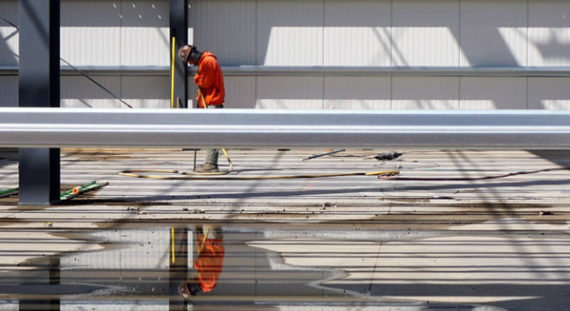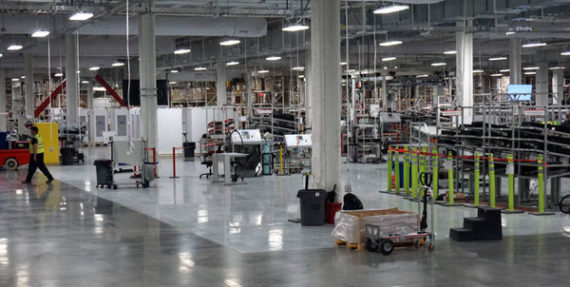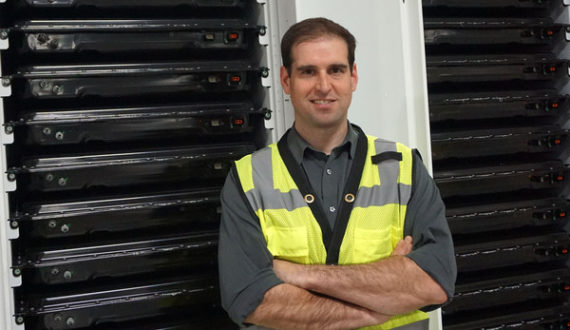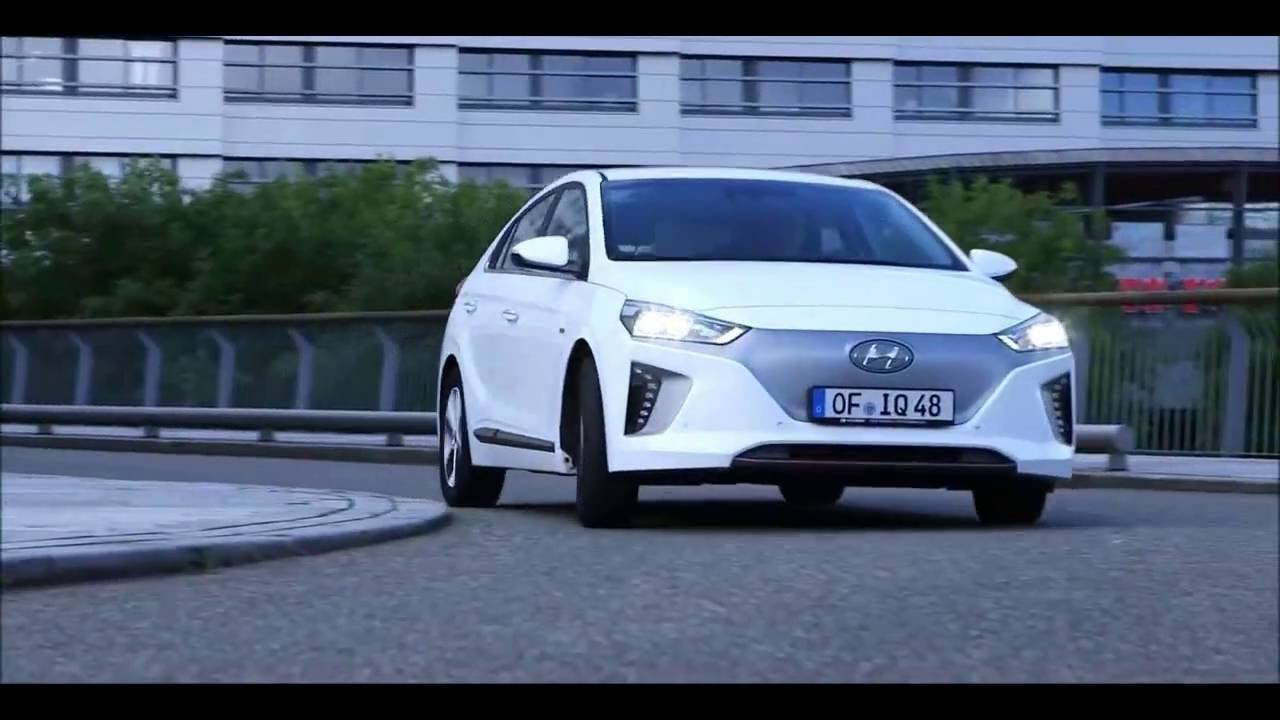Inside the Tesla Gigafactory
Bay area-based Tesla is in the midst of building what’s expected to be the world’s largest manufacturer of lithium ion batteries. Tesla so-called GigaFactory is rising up from the Nevada desert near Reno and is being touted as a potential game-changer in the efforts to reduce greenhouse gases.
The Mega plant is not only manufacturing batteries for Tesla’s electric cars but it’s also producing a new generation of batteries for the home.
KQED science reporter Lauren Sommer recently got a rare look inside the factory and she joins us now.
MC: Hi Lauren, How big is this GigaFactory is?
Lauren: It’s really hard to wrap your brain around. When I went to visit it’s just a small piece of there but is that 800,000 square feet, already which is the size of maybe a larger shopping mall. When it done, it’ll be 5.8 million square feet, about 100 football fields and this one building, one massive building where one wall is three-quarters of a mile. But scale what they’re going for. The whole idea is to ramp up production batteries to ramp up production of cars

MC: and why is it so important for them to have their own production.
Lauren: Yeah, so battery have been expensive for the most part. I mean it’s a big part of the sticker price for one of their cars. $10,000 or more for these battery packs that power them. So they’re betting that with a massive factory and this is going to double the capacity to make lithium-ion batteries in the world with their own factory they can drive down of these batteries 30% or more. Which they say is going to help to drive down the cost of cars to make them more affordable for average people.
MC: And I have heard that once this is completed this will be bigger than all of the current lithium ion battery plants combined in the world.
Lauren: Yes, it gives you a sense of just the bet that they’re making right that. They are going all in on this future where they’re expecting average people to want electric cars, to drive electric cars. And this factory is kind of the embodiment of that gamble.
MC: So you got such a rare access inside the factory. What did you see?
Lauren: Yes, they’re moving in as soon as each room is done. So part of the factory you can already see the production line, humming, batteries rolling off the line and then the rest of it is just the most massive construction site. You know trucks, people, tons of noise, just room after room after room. And it’s a lot of equipment. As you might imagine, it’s almost like a bakery except they are taking the raw ingredients for batteries. They bake them in these big events. They mix them. It’s just massive amounts of equipment.

Construction continues on the Gigafactory exterior
MC: And they are often very secretive as you know where their many areas that were off limits?
Lauren: We got to walk around, you know a lot of it no pictures in some places. Because this is proprietary equipment in many cases that they are working with Panasonic to develop this GigaFactory.
There also a little bit secretive as a company right, I mean they want to kind of cultivate this ethos as being a very exclusive. Kind of exciting company to get their cars.
MC: The Factory is introducing electric car batteries just yet, but it has started making another kind of battery that allow surplus solar energy to be stored at home. Tell us about that.
Lauren: Yes, this is going to be really fascinating to see how people deal with this product. It is a battery for your house - Powerwall. It’s something you would put on the wall of your garage and if you have solar panels that extra solar energy you make during the day, we get stored in the battery so you can use your solar energy at night and people like this idea! The idea that your house could run off your solar energy well into the evening and you wouldn’t have to buy electric from your utility.

Tesla’s Powerwall production line.
MC: for home owner want to buy, it is at about $3,000 for one of these things?
Lauren: It’s not cheap and here in California, there is kind of another wrinkle which is if you have solar energy in your house, you could sell the extra back to grid. So if you don’t use all of it, they will pay you full retail price for that electricity and that makes it kind of maybe not the best financial choice for store your own electricity because you’re getting a great price for the electricity from your utility. Now, there’s going to be early adopters and just like the idea of storing their electricity at their own battery at their house but financially you don’t really recruit that $3,000 very fast.

Production is underway for Tesla’s home battery, the Powerwall

Tesla CTO JB Straubel in front of Powerpacks, refrigerator-size batteries for factories or electric utilities
MC: And then taking a look into the future, last month unveiled its new electric car – The Model 3, nearly 400,000 people have already put $1,000 down payment to reserve this car. Or something that hasn’t even gone into production yet. Why is there so much hype around this car.
Lauren: I think there is a couple reasons you know. One this is their first mass-market car. It has a range of more than 200 miles which is good compared to the other cars that are out there, people like that and then part of it is maybe the ethos of Tesla. They’ve kind of cultivated this luxury brand their cars now, you know $75,000 before some of the tax incentives. So to have a car but $28,000 after you get the federal tax credit, I mean that’s a big draw for people that maybe even waiting to get into the electric car market and maybe this was the real opportunity to do it.
MC: I just have to ask you this will quickly kind of related also on the issue of green energy. This week the San Francisco – Board of Supervisors approved a bill requiring solar panels on new buildings. What are the details and when does it take effect.
Lauren: So this is for building that are 10 stories or less. of it doesn’t skyscrapers what talking about. But starting next year if you build one of those new buildings and you have to put solar on it and it’s a big sign from the city that they’re very serious about clean energy and they want new buildings to play a part in that.
Source: KQED Newsroom
You can check out some other pictures about Tesla GigaFactory bellow.
Have you a channel youtube and want to bring your Video to quality visitors?
Do you want your video to appear on our website?
Do you want to become partner with us?
Just 3 steps to become our partner:
Step 1: Make video review for mods, addons, plugins, ... which you like
Step 2: Upload this video to youtube and our link to your video description
Step 3: Send the youtube video link via message to http://fb.com/9lifehack or leave a comment in the post. We will add your video in the our post, it will help you have more view.
JOIN to get more youtube view with us!!!!
